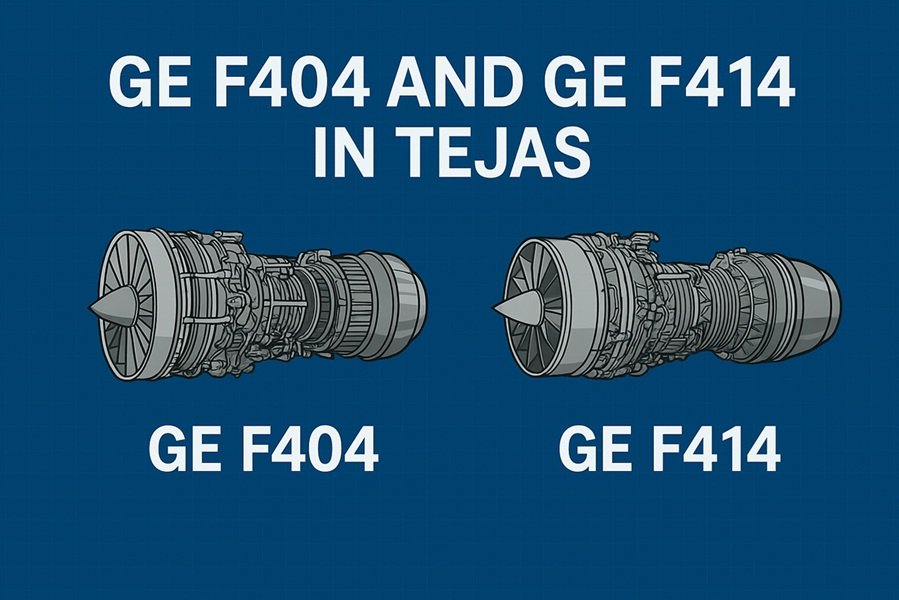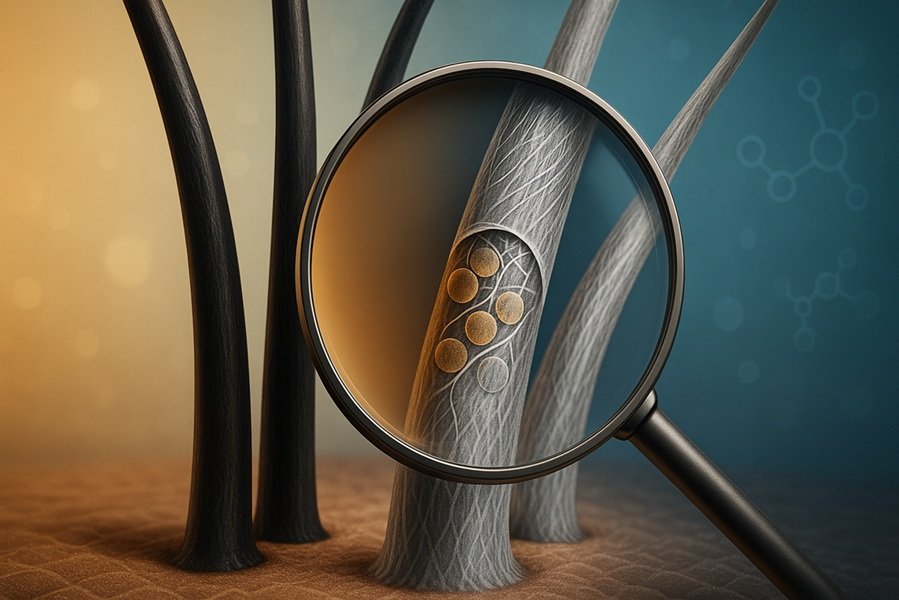
GE F404 and GE F414 in Tejas — Everything Explained
Executive summary
- F404-GE-IN20 (often referred to as GE404 in India) is the uprated F404 variant powering the Tejas Mk1 / Mk1A family. It provides about ~19,000 lbf thrust with afterburner and a modern FADEC control suite. (Wikipedia)
- F414 (branded as F414-GE-INS6 / GE414 in Indian programmes) is a more powerful derivative of the F404 designed for higher thrust (≈22,000 lbf / ~98 kN) and improved airflow; it has been selected to power the Tejas Mk II (Mk2) and future LCA variants to meet growth-in-weight and performance requirements. (Wikipedia)
1. Short history — how the two engines tie into the Tejas programme
- The Tejas Light Combat Aircraft (LCA) project began in the 1980s. From early stages GE’s F404 family was the natural choice because the F404 was already proven, physically compatible with light fighters, and offered manageable risk for a first-time Indian indigenous fighter programme. GE supplied early F404 variants for prototypes and initial Tejas flight test aircraft. (Wikipedia)
- As Tejas evolved (higher weight, more avionics, more weapons), HAL/ADA and the Indian Air Force planned a higher-thrust engine for the Mk II / future variants. GE’s F414 — an enlarged and improved derivative of the F404 — was selected for that role. GE and ADA signed production/supply agreements for F414s to power the Mk II. (GE Aerospace)
Read This also: NOTAM: Meaning, Purpose, Types, and Importance in Aviation Safety
2. Technical comparison (core differences and what they mean)
Core architecture and lineage
- Both engines belong to the same family lineage — the F414 grew out of the F404 (and related F412 work). They share design philosophy (modular cores, FADEC control options) but the F414 has a larger low-pressure fan and higher airflow. (Wikipedia)
Thrust
- F404-GE-IN20 (Tejas variant): ~19,000 lbf (afterburning). This was an uprated F404 variant tailored for the Indian LCA. (Wikipedia)
- F414: roughly 22,000 lbf (~98 kN) class depending on subvariant — a clear thrust step up versus the F404 and enough margin for heavier future Tejas configurations, naval variants, and more weapons/payload. (Wikipedia)
Fan / airflow & performance envelope
- The F414 uses a larger fan (bigger diameter, ~16% more airflow vs. F404 family), which gives higher mass flow and better off-design performance (important for heavier aircraft, carriage of external stores, hot/higher-altitude operations). This is a primary reason F414 was chosen for the Mk II. (Wikipedia)
Electronic engine control (FADEC)
- Modern FADEC is standard for F404-IN20 and for F414 variants selected for Tejas. FADEC ensures engine/airframe integration, automatic management of limits, and easier diagnostics/service-by-condition. FADEC software & IP is often a key part of integration discussions and industrial offsets. (GE Aerospace)
3. Why F404 for Tejas Mk1/Mk1A and F414 for Tejas Mk II — programmatic reasons
For Mk1 / Mk1A:
- The Tejas initially had a lower take-off weight and modest growth margin; the F404-IN20 provided the required thrust for Mk1 operations and allowed HAL to bring an operational fighter into service quickly with lower technical risk. The IN20 variant incorporated improved hot-section materials and FADEC compared to earlier F404s. (Wikipedia)
For Mk II:
- The Mk II (Tejas Mk2) is heavier (stronger airframe, more fuel, weapons, sensors), and its performance goals (higher thrust-to-weight, supersonic dash, sustained turn rates with weapons) demanded a higher-thrust engine. The F414 meets these performance needs with increased airflow and thrust margin, while keeping development risk low because it is a matured derivative of the F404. (GE Aerospace)
4. Procurement, delivery & industrial aspects (India context)
Contracts & numbers
- ADA/HAL selected the F414 for the Mk II programme; GE issued press material announcing selection and supply arrangements. For the Mk1A, India signed a multi-year supply and support deal for 99 F404-IN20 engines (2021 contract) to meet IAF orders and spares; deliveries have been ramping up but experienced supply-chain delays. (GE Aerospace)
Transfer of Technology and local production
- For big defence engines, India aims to maximize industrial participation and technology transfer (ToT). Discussions around ToT for F414 production/maintenance in India have been public — HAL has targeted a high percentage of indigenisation in maintenance and support, although sensitive items (especially FADEC software and certain hot-section materials) typically remain tightly controlled by the OEM or supplied under restrictive licensing. Independent reports indicate HAL targeted high ToT but GA/GE retained control over some software/IP areas in initial deals. (IDRW)
Supply chain & schedule risks
- Recent reporting (2024–2025) highlighted supply chain and supplier quality issues that delayed engine deliveries for Tejas Mk1A (including failures at an overseas supplier). GE and HAL have publicly committed to accelerating deliveries; India has also looked at parallel options for spares and in-country MRO capacity. (The Economic Times)
5. Integration & engineering challenges
Airframe installation
- Even when an engine “fits” in the same footprint, integration requires:
- Changes to inlets/ducting for altered airflow and pressure recovery
- Re-sizing of engine mounts and structural load paths for higher thrust
- Re-balancing fuel feed, start systems, and bleed air usage
- Thermal protection and rearranged line-replaceable units for maintainability
Controls & FADEC
- FADEC integration is more than wiring — the engine control laws interact with flight control software, weapons systems, and diagnostics. Certification requires rigorous flight testing and software verification. FADEC also gives diagnostic data which HAL/IAF need to use for predictive maintenance planning. (GE Aerospace)
6. Operational impact — what pilots and IAF gain
- Higher thrust (F414) = better hot/higher altitude performance, higher payload or range with same take-off run, improved acceleration & climb, enhanced safety margins on single-engine scenarios, and better performance carrying external stores/weapons. This is especially valuable for operations in the Himalayas, hot Indian summer conditions, and long-range strike missions. (Wikipedia)
- FADEC & diagnostics in both engines improve engine life management and reduce unscheduled maintenance by enabling on-condition maintenance rather than fixed overhauls. GE advertises modular design to maximize engine availability. (GE Aerospace)
7. Maintenance, lifecycle costs & availability
- F404 (IN20): modular architecture, on-condition maintenance, and no scheduled overhauls approach (per GE materials) reduce downtime but still require skilled MRO and supply of LRUs (line-replaceable units). (GE Aerospace)
- F414: similar modular philosophy but higher complexity and different parts (larger fan, greater airflow) means spare pool and logistic tail is different. Lifecycle cost depends heavily on flight hours, mission mix (high afterburner usage increases hot-section wear), and availability of local MRO capabilities. India’s aim to build MRO capacity domestically will be a decisive factor in lifecycle economics. (Wikipedia)
8. Key risks, limitations and mitigations
Risks
- Supply-chain and delivery delays — earlier F404 deliveries were affected by supplier issues. Similar risks exist for F414 supply unless robust multi-source logistics and local MRO are in place. (The Economic Times)
- Technology & software IP — FADEC software and some advanced materials/processes are typically controlled by OEMs; Indian industry will need negotiated ToT or licensed manufacturing to reduce long-term dependency. (IDRW)
- Integration & certification time — fitting F414 to an airframe (even one that’s F404-derived) takes engineering, testing and certification time: structural loads, thermal, inlet compatibility and flight handling must be validated. (Wikipedia)
Mitigations
- Building in-country MRO and select production under license, staged ToT, parallel supply agreements, and contingency stockpiles for critical LRUs are standard mitigations. The existing F404 supply program and recent agreements show movement toward faster delivery rates and ramped support. (India Today)
9. Where things stand (short timeline & outlook)
- Mk1 / Mk1A: F404-IN20 engines are the operational baseline. India signed a supply support deal (2021) for a large batch of F404 engines and has been ramping deliveries; some delays were reported but GE/HAL have been working to accelerate supplies. (GE Aerospace)
- Mk II / future LCA variants: F414 selection has been publicly announced as the higher-thrust option for Mk II. Workstreams around ToT, certification, and engine-airframe integration are ongoing (and expected to continue as Mk II proceeds into prototype and serial development). (GE Aerospace)
10. Practical summary for readers (pilots, engineers, policy watchers)
- If you want higher payload, range and hot-altitude performance in future Tejas variants, F414 is the right engine class — that’s why it was chosen. (Wikipedia)
- For immediate operational induction and lower program risk, the F404-IN20 was the sensible baseline for Mk1/Mk1A and remains the workhorse powering current LCA fleets. (Wikipedia)
- The long-term strategic objective for India is not just procurement but building sustainment capability — local MRO, licensed manufacture of replaceable modules and negotiated ToT to reduce foreign dependency and lower lifecycle costs. Reports indicate HAL is pursuing that, while some sensitive software/IP likely remains under GE control initially. (IDRW)
References & further reading (selected)
- GE Aerospace — F404 family datasheet & product pages. (GE Aerospace)
- GE press release — selection of F414 engines for India LCA Mk II. (GE Aerospace)
- Wikipedia / technical summaries of F404 & F414 families (good quick reference and specs). (Wikipedia)
- Recent Indian press reporting on F404 deliveries and supply chain acceleration (EconomicTimes / IndiaToday / Swarajya). (The Economic Times)
- Industry analysis pieces on F404 vs F414 performance differences and fan/airflow changes. (AirPra)





